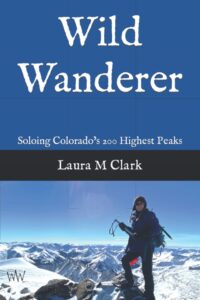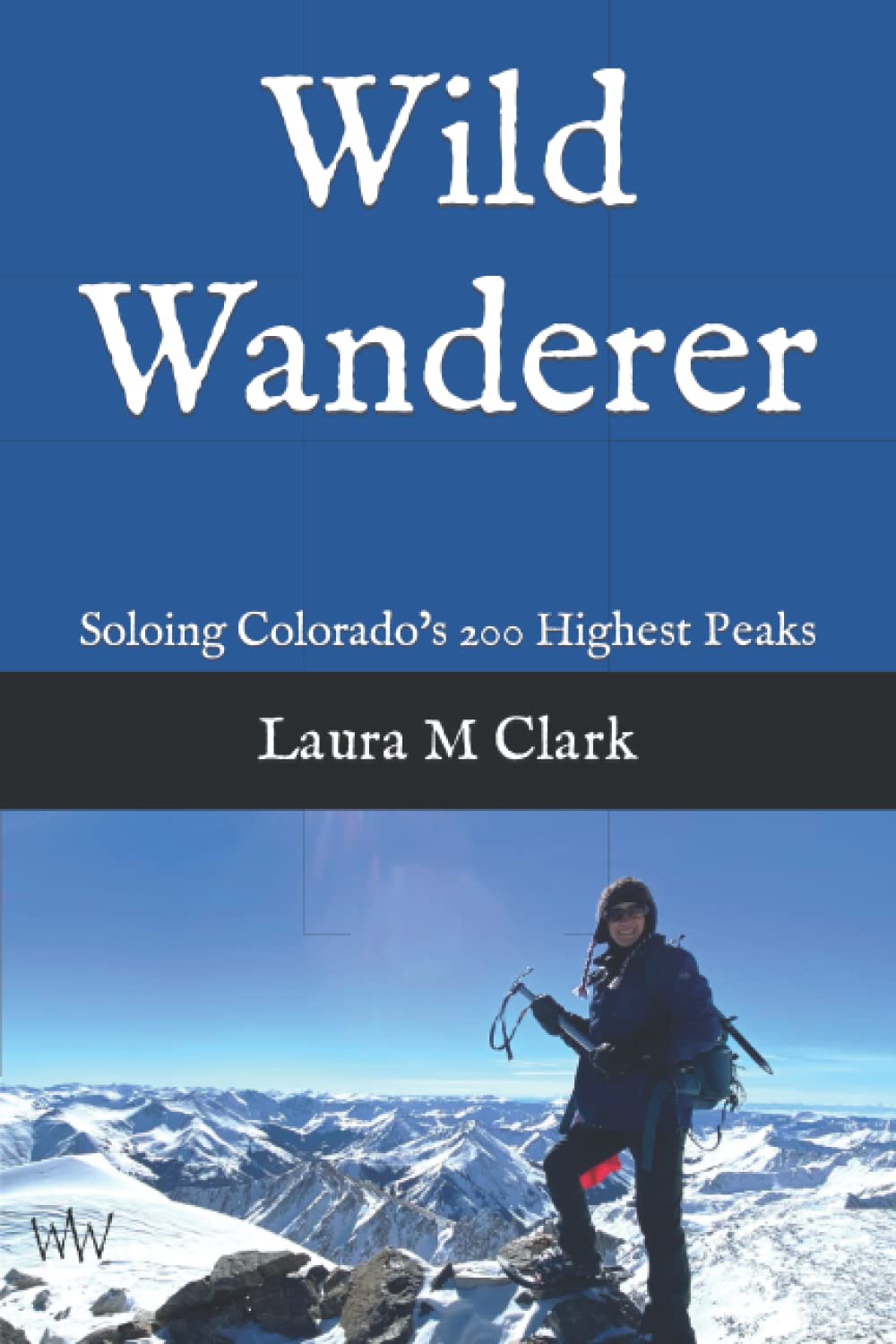On becoming a wild wanderer
Climber solo summits the state’s highest peaks amid self-discovery and intense scrutiny
Climber solo summits the state’s highest peaks amid self-discovery and intense scrutiny
There’s a point near the end of Laura M. Clark’s book, Wild Wanderer: Soloing Colorado’s 200 Highest Peaks, when she finds herself on a trail to the summit of Peak Fifteen. With a partner.
Peak Fifteen is a 13,671-foot peak in the San Juan Mountains of Colorado.It’s considered one of the more difficult 13,000-plus feet climbs in Colorado and is rated class 5.0 to 5.2; its exposure and steepness require ropes and the experience to use them.
Clark’s visit to Peak Fifteen with a partner wasn’t by accident. She had soloed the state’s 58 14,000-foot peaks in a year and was now almost finished solo summiting the Bicentennial peaks (highest 200). Soloing was how she climbed, with her own carefully researched routes, her own timetable and her own blistering speed.
Clark had attempted to climb the remote peak—the final one of the 200 for her —a month earlier and reluctantly turned around when she encountered dangerous water flowing down a couloir. This was one of the most technical summits of her climbing career, and she knew it was too dangerous for her to continue alone.
So she retreated. She had returned with a longtime friend who had been her mentor when she started climbing. Her plan: to reach the summit with her friend and return alone at a later date, so she could still reach her solo project goal.
As Clark and her partner hiked the trail to the peak (a long approach in the Weminuche Wilderness at more than 53 miles round trip with 13,765-foot elevation gain), she found herself frustrated by their pace.
 “I was doing my best to listen to the needs of my partner,” she writes. “When you hike solo, you don’t have to take those kinds of things into account. I was trying not to get worked up about what I couldn’t change. Like our hiking speed, which was apparently ‘smiles before miles.’”
“I was doing my best to listen to the needs of my partner,” she writes. “When you hike solo, you don’t have to take those kinds of things into account. I was trying not to get worked up about what I couldn’t change. Like our hiking speed, which was apparently ‘smiles before miles.’”
Clark, a tiny, incredibly fit woman, had spent years fine-tuning her hiking pace, and when she was alone, it was impressive—she would regularly drive to a remote trailhead at night, sleep a few hours in her truck or a bivy sack, and then hike 30 or 40 miles in a day, eating very little along the way and rarely stopping until she reached the summit and returned to the trailhead.
“I felt I was better solo,” she confessed. But this time, on this jagged, remote peak, she knew she needed a partner. She was right, and together, they summited Peak Fifteen on her 41st birthday. Over the last four years, she had summited more than 500 peaks alone.
Wild Wanderer is a self-published diary of those climbs. At times compelling and at times a bit tedious as the author dwells on minute details, Clark’s book does have a bit of an identity crisis. Listed under “traveler and explorer biographies” on Amazon, it is part guidebook, with detailed trip data and climbing information. It is part memoir, as Clark writes about her struggles as a single mom. It is part adventure tale, describing encounters with frisky marmots and grumpy moose and frigid nights fueled by a handful of nuts and a shot of whiskey.
And at times, Clark is an apologist, responding to other climbers’ beliefs that she was too much of a self-promoter, and defending herself to others who felt that climbing alone was unsafe and irresponsible.
A divorced mom of three who had her first child at 17, Clark first set foot on a mountain trail as the leader of a group of Girl Scouts on Pikes Peak. The mountain that forms the backdrop for her hometown, Colorado Springs, Pikes Peak had beckoned her ever since she had moved to Colorado from California.
Soon, she was inviting other friends to join her on Barr Trail—the 12.7-mile path that leads to the summit of Pikes Peak. When a friend bailed one day, Clark decided not to cancel her plans. She asked her daughter if she should attempt the round-trip alone.
“She told me I should go,” Clark writes. “She also said she’d look for me if I didn’t come back by the next night. And by ‘look for me,’ she meant drive to the trailhead and yell as loud as she could. She’s not much of a hiker.”
Clark discovered her affinity for hiking alone and the fact that most people she knew didn’t have the drive that fueled her to explore the high peaks of her adopted state. After her successful solo summit of Pikes Peak, she was hooked,and began her challenge of climbing all of the state’s 58 fourteeners (peaks higher than 14,000 feet) solo. When she reached that goal, she began exploring peaks higher than 13,000 feet. Soon, she had climbed more than 500 peaks alone, documenting her journeys with detailed information and photographs on her website, www.wildwandertripreports.com.
On the flanks of Colorado’s mountains, she honed her skills and learned what she still needed to work on, and when she returned home, she would practice yoga and frequent a climbing gym. As she continued to solo successfully, navigating gullies and scree slopes, she came upon another obstacle, more daunting than the physical challenges she had met on the mountains. Her trip reports and claims to be the first woman to solo the state’s 58 highest mountains were met with criticism.
“I did my research, and while there were a lot of unique ‘firsts’ for 14ers, I couldn’t find any other women who soloed them all,” she writes. So she posted a question on the most popular 14er online forum, asking if anyone knew of a person holding that record. “If no one had, I’d like to claim the title,” she wrote.
The online response was quick and fierce with comments about the dangers of hiking solo. Commenters and climbers called her out for her self-promotion and accused her of lying. Clark was blindsided by the response to a feat she thought would be celebrated, and she writes that she retreated alone to the place she knew best, the mountains.
“I’d learned so much from hiking solo, but most importantly, I’d learned to like myself,” she writes. “Hiking for thousands of hours in the wilderness alone gave me a lot of time to think. Sometimes, the best hikes were the ones I’d done on days I didn’t feel like hiking.”
She continued her climbing and logging of trip reports, driving to remote trailheads and exploring more wild places. She was still on the trail every weekend, but this time was different, she writes. “I just wasn’t going to tell anyone.”
As she closes out Wild Wanderer, Clark muses about her solitary quest. After returning from Peak Fifteen with her one-time climbing partner, she wondered if she was really better solo or if she just needed to find the right partner. She replayed that vexing summit in her head and decided that it was no less an accomplishment as part of a team.
She writes,“I am in no way finished.”
Deb Acord is a journalist and author from Woodland Park, Colorado. For decades, she wrote for The Colorado Springs Gazette, Rocky Mountain News, Denver Post and The Indy. At the Gazette, she was co-creator of Out There, a section devoted to the outdoors of Colorado. She is the author of Colorado Winter and Biking Colorado’s Front Range Superguide and has writtten car trend stories and environmental stories for Popular Mechanics.
Click here for more from Deb Acord.

